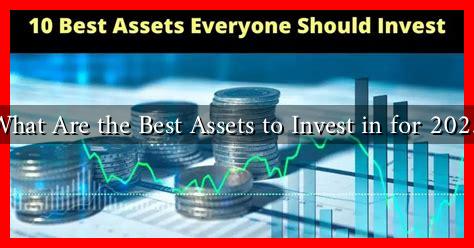-
Table of Contents
What Are the Best Assets to Invest in for 2025?
As we approach 2025, investors are increasingly looking for opportunities that promise growth and stability in an ever-evolving economic landscape. With the rise of technology, shifts in consumer behavior, and global economic changes, understanding the best assets to invest in is crucial. This article explores various asset classes that are expected to perform well in 2025, backed by research and expert opinions.
1. Technology Stocks: The Future is Now
Technology continues to be a driving force in the global economy. As digital transformation accelerates, investing in technology stocks can yield significant returns. Key areas to consider include:
- Artificial Intelligence (AI): Companies specializing in AI, such as NVIDIA and Alphabet, are at the forefront of innovation. The AI market is projected to grow from $62.35 billion in 2020 to $733.7 billion by 2027, according to Fortune Business Insights.
- Cybersecurity: With increasing cyber threats, firms like CrowdStrike and Palo Alto Networks are essential for businesses. The global cybersecurity market is expected to reach $345.4 billion by 2026.
- Cloud Computing: Companies like Amazon Web Services and Microsoft Azure are leading the charge in cloud services, which are projected to grow significantly as more businesses migrate to the cloud.
2. Renewable Energy: A Sustainable Investment
As the world shifts towards sustainability, renewable energy assets are becoming increasingly attractive. The International Energy Agency (IEA) predicts that renewable energy will account for 80% of global electricity by 2030. Key investment areas include:
- Solar Energy: Companies like First Solar and SunPower are making strides in solar technology, which is expected to see a compound annual growth rate (CAGR) of 20.5% from 2021 to 2028.
- Wind Energy: With advancements in turbine technology, companies such as Vestas and Siemens Gamesa are well-positioned to benefit from the growing demand for wind energy.
- Energy Storage: As renewable energy sources become more prevalent, energy storage solutions from companies like Tesla and LG Chem will be critical for managing supply and demand.
3. Real Estate: A Tangible Asset
Real estate remains a solid investment choice, particularly in markets with strong growth potential. Factors to consider include:
- Residential Properties: With remote work becoming more common, suburban and rural areas are seeing increased demand. Investing in single-family homes or multi-family units can provide steady rental income.
- Commercial Real Estate: As businesses adapt to new norms, sectors like logistics and warehousing are thriving. REITs (Real Estate Investment Trusts) focused on these areas can offer attractive returns.
- Real Estate Crowdfunding: Platforms like Fundrise allow investors to pool resources for real estate projects, making it easier to diversify without significant capital.
4. Cryptocurrencies: The Digital Gold
Cryptocurrencies have gained traction as an alternative asset class. While they are volatile, the potential for high returns is enticing. Key considerations include:
- Bitcoin: Often referred to as digital gold, Bitcoin has a finite supply, making it a hedge against inflation.
- Ethereum: With its smart contract capabilities, Ethereum is positioned to benefit from the growing decentralized finance (DeFi) sector.
- Stablecoins: For those wary of volatility, stablecoins like USDC offer a way to invest in cryptocurrencies while minimizing risk.
5. Commodities: A Hedge Against Inflation
As inflation concerns rise, commodities can serve as a hedge. Key commodities to consider include:
- Gold: Traditionally viewed as a safe haven, gold prices often rise during economic uncertainty.
- Silver: With industrial applications and investment demand, silver can be a valuable addition to a diversified portfolio.
- Energy Commodities: Oil and natural gas prices are expected to fluctuate, but investing in energy commodities can provide opportunities for profit.
Conclusion: Diversification is Key
As we look towards 2025, the best assets to invest in will likely be those that align with technological advancements, sustainability, and economic resilience. Diversifying across various asset classes—such as technology stocks, renewable energy, real estate, cryptocurrencies, and commodities—can help mitigate risks and maximize returns. Investors should conduct thorough research and consider their risk tolerance before making investment decisions. For more insights on investment strategies, consider visiting Investopedia.
In summary, the investment landscape is evolving, and staying informed about emerging trends will be crucial for success in the coming years.

